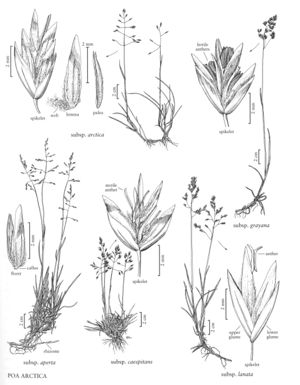Difference between revisions of "Poa arctica subsp. caespitans"
FNA>Volume Importer |
imported>Volume Importer |
||
| (5 intermediate revisions by 2 users not shown) | |||
| Line 7: | Line 7: | ||
|name=Poa arctica var. vivipara | |name=Poa arctica var. vivipara | ||
|authority=Hook. | |authority=Hook. | ||
| + | |rank=variety | ||
}} | }} | ||
|hierarchy=Poaceae;Poaceae subfam. Pooideae;Poaceae tribe Poeae;Poa;Poa subg. Poa;Poa sect. Poa;Poa arctica;Poa arctica subsp. caespitans | |hierarchy=Poaceae;Poaceae subfam. Pooideae;Poaceae tribe Poeae;Poa;Poa subg. Poa;Poa sect. Poa;Poa arctica;Poa arctica subsp. caespitans | ||
| Line 19: | Line 20: | ||
-->{{Treatment/Body | -->{{Treatment/Body | ||
|discussion=<p><i>Poa arctica </i>subsp.<i> caespitans</i> grows in moist tundra of the high arctic, or infrequently in the low arctic of northeastern Canada and Greenland. It also grows in Norway and in the Russian high arctic; it is rare in both regions.</p><!-- | |discussion=<p><i>Poa arctica </i>subsp.<i> caespitans</i> grows in moist tundra of the high arctic, or infrequently in the low arctic of northeastern Canada and Greenland. It also grows in Norway and in the Russian high arctic; it is rare in both regions.</p><!-- | ||
| − | --><p>Many plants included here tend towards <i>Poa glauca</i> (p. 576, e.g., scabrous branches, and intermediate leaf and panicle forms), while others are distinguished from other <i>P. arctica</i> subspecies only by their more tufted habit and sterile anthers. As interpreted here, < | + | --><p>Many plants included here tend towards <i>Poa glauca</i> (p. 576, e.g., scabrous branches, and intermediate leaf and panicle forms), while others are distinguished from other <i>P. arctica</i> subspecies only by their more tufted habit and sterile anthers. As interpreted here, <i></i>subsp.<i> caespitans</i> includes P. trichopoda Lange [= P. tolmatchewii Roshev.].</p> |
|tables= | |tables= | ||
|references= | |references= | ||
| Line 28: | Line 29: | ||
-->{{#Taxon: | -->{{#Taxon: | ||
name=Poa arctica subsp. caespitans | name=Poa arctica subsp. caespitans | ||
| − | |||
|authority=Simmons ex Nannf. | |authority=Simmons ex Nannf. | ||
|rank=subspecies | |rank=subspecies | ||
| Line 35: | Line 35: | ||
|basionyms= | |basionyms= | ||
|family=Poaceae | |family=Poaceae | ||
| + | |illustrator=Sandy Long | ||
| + | |illustration copyright=Utah State University | ||
|reference=None | |reference=None | ||
|publication title= | |publication title= | ||
|publication year= | |publication year= | ||
|special status= | |special status= | ||
| − | |source xml=https:// | + | |source xml=https://bitbucket.org/aafc-mbb/fna-data-curation/src/200273ad09963decb8fc72550212de541d86569d/coarse_grained_fna_xml/V24/V24_745.xml |
|subfamily=Poaceae subfam. Pooideae | |subfamily=Poaceae subfam. Pooideae | ||
|tribe=Poaceae tribe Poeae | |tribe=Poaceae tribe Poeae | ||
Latest revision as of 17:25, 11 May 2021
Plants densely to moderately densely tufted, rhizomatous, rhizomes very short, poorly developed. Sheaths closed for (1/5)1/3 their length, terete; ligules 2-4 mm, obtuse to acute; blades 1-2.5 mm wide, flat or folded, moderately thick. Panicles lax to erect, open; branches ascending or widely spreading, sinuous and flexuous to fairly straight, smooth or the angles moderately or densely scabrous, proximal branches 1/4-1/2 the panicle length. Spikelets 4.5-8 mm, laterally compressed, infrequently bulbiferous; rachilla internodes usually glabrous, infrequently sparsely softly puberulent; calluses webbed; lemmas 3-6 mm; palea keels glabrous or long-villous; anthers usually aborted late in development, infrequently fully developed. 2n = 56, ca. 66, ca. 80.
Discussion
Poa arctica subsp. caespitans grows in moist tundra of the high arctic, or infrequently in the low arctic of northeastern Canada and Greenland. It also grows in Norway and in the Russian high arctic; it is rare in both regions.
Many plants included here tend towards Poa glauca (p. 576, e.g., scabrous branches, and intermediate leaf and panicle forms), while others are distinguished from other P. arctica subspecies only by their more tufted habit and sterile anthers. As interpreted here, subsp. caespitans includes P. trichopoda Lange [= P. tolmatchewii Roshev.].
Selected References
None.
